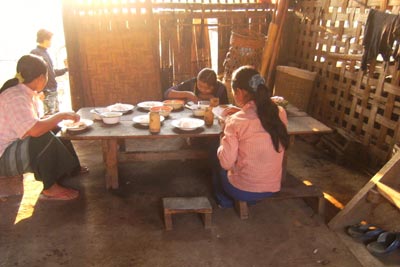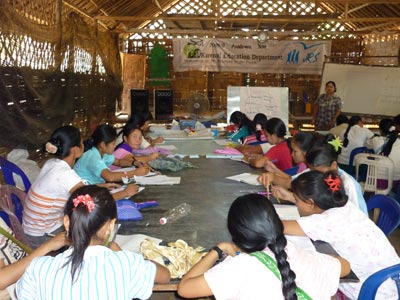It’s the start of the new school year and it looks like many Karenni children, on both sides of the border will be denied an education.

Young trainee teachers in displaced communities take a well earned rest. Photo: Kantarawaddy Times
Schools in refugee camps have a chronic shortage of teachers and teachers working in displaced communities on the Burma side of the border worry about their security – landmines and attacks by the Burma Army.
Teachers working in displaced communities also worry about the isolation and a lack of medical care and medicine if they get sick. Many displaced communities are in malaria-affected areas and getting medical assistance usually requires a seven day trek to the border.
Karenni teachers in the refugee camps are leaving to be resettled in the US, Finland, Australia and New Zealand and are not being replaced. This has placed a heavy strain on the remaining teachers and students are not getting the education they need.
Class sizes have doubled, they have jumped to as many as 90 students. And in some cases older inexperienced students are working as teachers.
Mr Michael, in charge of high school and middle school, for the Karenni Education Department says.
“We don’t have enough teachers, schools are having trouble finding qualified teachers in the refugee camps. We depend on the school to find teachers and we will pay their salary.”

Karenni teachers juggles a large refugee school class.
Photo: Kantarawaddy Times
Mr Michael blames resettlement for the low number of teachers in the camp for the four middle schools and one high school.
“Last year we had 110 teachers for the middle high school, but we have lost 95 who resettled to another country.”
Mr Michael says at beginning of the year there were 22 high school teachers in the camp.
“Resettlement took 16 of those, leaving us with six teachers just before the start of the new school year. We had to hire another 17 teachers to fill the gap.”
Mr Michael explains out of the 23 teachers hired he does not know how many will stay or be lost to resettlement.
“It’s hard to plan our school year, not knowing who will stay or leave.”
Lkhun, the director of the Karenni Education Department, has just returned from Maw Chi District in Karenni State where he ran a teacher training course for new teachers and says the situation there is also dire.
“In the displaced communities it is bad. Out of 82 villages only three have schools. Many students will miss out on getting educated. The three schools are supported by the parents.”
Lkhun says many of the teachers in displaced communities are not qualified.
“Many are young and have just finished their middle school education. They are very young and inexperienced. It’s hard work. They need support, many don’t have teacher training and don’t know how to develop the curriculum, they don’t have books for reference or course notes.”
Lkun says displaced communities have no stability and children’s education is constantly disrupted.
“They have to leave their villages. The Burma army attacks these communities as they have classified them as ‘shoot-on-sight’ zone. They get little support if any. International organizations can’t access these people.”
Lkhun says the training course he ran in Karenni State was the first training for many of these young teachers.
“It was a one month course. It’s not a lot but it’s a start. We focused on developing the curriculum and lessons plans, how to manage their time and resources.”
Education in Burma for ethnic people is poor. The John Hopkins School of Public Health reports that the Burma military dictatorship spends three percent on education and health - one of the world’s lowest expenditures on health by any government.
The Thai Burma Border Consortium estimates that there are as many as 500,000 internally displaced people in eastern Burma and about 145,000 Burmese refugees in camps in Thailand.
Lkun says one out of two children in displaced communities will miss out on schooling.
Shar Myar, a student from Ban Mai Nai Soi Camp One, says last year she completed 10th Grade and this year she has been selected to attend leadership training and says.
“Last year my class started at 30 students, but because teachers left during the semester, it grew to 50. It was noisy and hard to hear what the teachers said, especially at the back of the class. We had to go to school in shifts, because there were no teachers. I was worried I would fail the exams to get into leadership training.”
Shar Myar is one of the lucky students, but for many Karennin students, getting an education is a lottery.



